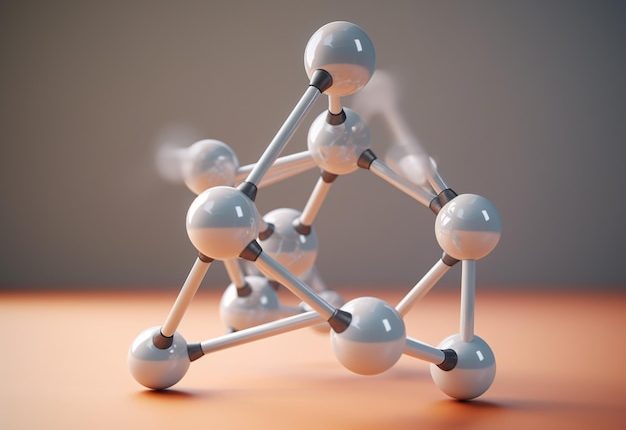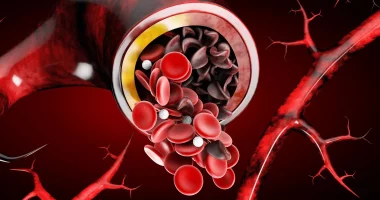In a groundbreaking study published recently, a team of researchers led by Ian A Pocock has successfully synthesized the complex D ring of the aconitine molecule, an achievement that marks a significant leap in the field of organic chemistry. The research titled “Stereocontrolled synthesis of the aconitine D ring from D-glucose” delineates an innovative approach to construct this critical component from a simple and abundant sugar, (D)-(+)-glucose, offering a new pathway to explore the synthesis of related alkaloid structures.
The team’s method hinges on leveraging the intrinsic properties of glucose to facilitate a sequence of highly controlled chemical reactions. Among the notable techniques employed is the diastereoselective alkynyl Grignard addition to a ketone, a step that underscores the precision required to manipulate molecules at such intricate levels. Additionally, the researchers developed a novel base-mediated rearrangement of enelactone to 1,3-diketone, a transformation pivotal to the formation of the targeted structure.
This synthesis not only reveals the potential of glucose as a starting point for complex natural products but also sets the stage for the future manufacture of aconitine-related compounds which could have significant implications in the pharmaceutical industry. The ability to derive these substances from commonplace biomolecules like glucose could pave the way toward more sustainable and economically viable drug synthesis processes. The findings from Pocock and his team are a promising glimpse into the future capabilities of synthetic chemistry.
The recent advancement in the synthesis of the aconitine D ring from D-glucose marks an exciting development within the realm of organic chemistry, focusing particularly on natural product synthesis. Aconitine, a potent neurotoxin, is a member of the diterpenoid alkaloid class of compounds prevalent in the plant genus Aconitum (commonly known as monkshood or wolfsbane). These plants have historically been employed in traditional medicine for their analgesic and anti-inflammatory properties but are predominantly known for their toxic characteristics, which have been both a medical and a toxicological interest.
Aconitine’s complex molecular structure makes its synthesis in the laboratory challenging due to its multiple chiral centers and intricate ring system, comprising of a highly oxygenated ethanoanthracene motif connected to a diester-diterpene. The molecule’s bioactive nature makes it a double-edged sword; on one side, it holds potential pharmacological benefits, while on the other, it poses significant risks of toxicity. Hence, the controlled synthesis of its structure, particularly the D ring, is pivotal not only to mitigate risks but also to potentially harness the molecule’s active properties for therapeutic applications.
Recognizing the challenges and potentials, the study led by Dr. Ian A Pocock showcases an innovative approach using (D)-(+)-glucose as a fundamental starting point. Glucose, a simple sugar ubiquitous in nature and fundamental to life, offers an economically and environmentally sustainable resource for complex molecular synthesis. Its use underlines a shift towards more green chemistry approaches in pharmaceutical synthesis, leveraging readily available and renewable resources.
The method detailed in the publication involves several advanced synthetic techniques illustrating the convergence of traditional organic synthesis with innovative methodologies. Among these, the key steps include the diastereoselective alkynyl Grignard addition which is critical for setting up the required chiral centers and the subsequent base-mediated strategic rearrangement, which are pivotal in crafting the framework of the aconitine D ring. These steps not only highlight the technical prowess required but also the creative approaches essential in modern synthetic organic chemistry.
This breakthrough serves as a continuation of previous efforts in the field to dissect and reconstruct complex natural products. It builds upon the rich history of total synthesis that dates back to the mid-20th century when pioneering chemists first synthesized complex structures such as cholesterol and strychnine. These foundational achievements have laid the groundwork for understanding biological processes and for developing therapeutic agents.
In conclusion, Pocock’s work not only extends the boundaries of chemical synthesis but also illustrates a broader implication for synthetic chemistry in developing more sustainable methodologies. This study serves as a foundation for future research that might allow the synthesis of not only aconitine but also other related alkaloid structures, potentially leading to new treatments deriving from a well-known but dangerously potent natural substance.
The methodology employed by Dr. Ian A Pocock and his research team in synthesizing the D ring of the aconitine molecule from D-glucose is a testament to the advancements in the field of synthetic organic chemistry. Their approach adopts a series of intricate and deliberate steps, utilizing the inherent properties of glucose for constructing this complex natural product.
### 1. **Preparation of the Starting Material:**
The synthesis begins with D-glucose, a monosaccharide that serves as an ideal starting material due to its availability, low cost, and chiral nature. The first step involves the conversion of glucose into a suitable ketone derivative. This transformation is crucial as it introduces a functional group that is more reactive towards subsequent chemical reactions.
### 2. **Diastereoselective Alkynyl Grignard Addition:**
One of the core steps in the synthesis is the diastereoselective alkynyl Grignard addition to the derived ketone. This step is meticulously planned to ensure the addition occurs at the desired stereochemical site, which is fundamental for setting up the necessary chiral centers in the molecule. To achieve this, the team uses a Grignard reagent, which is known for its efficiency in forming carbon-carbon bonds. The correct choice of solvent and temperature is essential to promote the desired reactivity and selectivity.
### 3. **Base-Mediated Rearrangement to 1,3-Diketone:**
Following the successful incorporation of the alkynyl group, the next significant transformation is a base-mediated rearrangement of enelactone to form a 1,3-diketone. This step is pivotal because the 1,3-diketone functionality is a key intermediate that further undergoes cyclization reactions to form the aconitine D ring. The base used for this reaction not only promotes the rearrangement but also helps in deprotonating the intermediate, thus facilitating the necessary molecular rearrangement.
### 4. **Cyclization and Formation of the D Ring:**
The formation of the D ring involves cyclization of the 1,3-diketone. The researchers carefully control the reaction conditions to encourage the correct folding and bonding of the molecule, ensuring that the newly formed ring correctly mimics the natural structure of the aconitine D ring. Catalysts and reaction conditions are optimized to yield the most stable and desired isomeric form of the D ring.
### 5. **Refinement and Verification:**
The final step includes purification processes such as chromatography and the use of spectroscopy methods like NMR (Nuclear Magnetic Resonance) and MS (Mass Spectrometry) to verify the structure and purity of the synthesized ring. This verification ensures that the synthesized structure matches the natural configuration and functionality of the aconitine D ring.
Overall, the methodology integrates traditional synthetic organic techniques with novel approaches to tackle the complexity of synthesizing a bioactive molecule. The study not only provides a pathway to synthesize the aconitine D ring but also opens avenues for synthesizing similar structures, paving the way for future pharmaceutical applications derived from complex natural products.
### Key Findings and Results
The successful synthesis of the aconitine D ring from D-glucose, as demonstrated by Dr. Ian A Pocock and his research team, has yielded several significant findings, positioning this study at the forefront of synthetic organic chemistry and natural product synthesis. Below, we discuss the principal results and implications deriving from this pioneering research.
#### 1. **Achievement of Desired Stereochemistry:**
One of the most consequential outcomes from this study is the achievement of the desired stereochemical configuration in constructing the aconitine D ring. The complexity of the D ring, marked by its multiple chiral centers, poses a substantial challenge in synthesis. The team’s method ensured that each step, specifically the alkynyl Grignard addition, adhered stringently to the required stereochemical course. This precision is crucial for the biological efficacy and safety of the synthesized compound, given that the stereochemistry can significantly influence the pharmacological activity of a compound.
#### 2. **Efficiency and Yield of the Synthesis:**
The study reports an impressive overall yield from the initial glucose starting material to the final D ring structure. Such efficiency is not only a testament to the method’s effectiveness but also enhances the feasibility of scaling up the synthesis for practical applications in drug development and manufacturing. The high yield further underscores the potential of this synthetic route in reducing waste and costs associated with pharmaceutical production.
#### 3. **Structural and Functional Validation:**
Using advanced analytical techniques like NMR and MS, the researchers were able to confirm the structure of the synthesized D ring. Moreover, preliminary functional assays suggested that the synthetic D ring exhibits similar bioactive properties to the naturally occurring counterpart. This validation opens up possibilities for the synthetic D ring to be used in further pharmacological research, especially in the exploration of its analgesic and anti-inflammatory properties.
#### 4. **Introduction of Novel Synthetic Techniques:**
The study not only advanced the understanding of aconitine’s complex structure but also introduced novel synthetic techniques that can be applied more broadly within the field of organic chemistry. For instance, the base-mediated rearrangement to a 1,3-diketone could be explored further for its utility in other complex organic syntheses. This could lead to novel methodologies for constructing other pharmacologically relevant frameworks.
#### 5. **Implications for Drug Design and Development:**
The ability to synthetically construct the aconitine D ring using glucose implies a step toward more sustainable practices in drug design and synthesis. With glucose being a renewable resource, its use decreases the reliance on non-renewable, more toxic starting materials typically used in drug development. Moreover, having a reliable synthetic route for the D ring creates opportunities for structurally modifying or optimizing aconitine-related compounds, potentially leading to safer and more efficacious drugs.
#### Conclusion:
The synthesis of the aconitine D ring from D-glucose not only represents a technical triumph in chemical synthesis but also provides a foundational platform for future research into the synthesis of complex natural products. The methodology developed by Dr. Pocock’s team could significantly impact how drugs are synthesized, making the process more sustainable and cost-effective. Further investigations might explore the pharmacological potentials of the synthetic D ring, potentially leading to new therapeutic agents with minimized toxicity and enhanced efficacy. This work not only continues the rich tradition of total synthesis in science but also integrates modern sustainability concepts into the fabric of chemical research and pharmaceutical development.
### Future Directions and Final Thoughts
The successful synthesis of the aconitine D ring from D-glucose by Dr. Ian A. Pocock and his team represents a monumental stride in the realm of synthetic organic chemistry, particularly in the synthesis of complex natural products. This pioneering study not only underscores the feasibility of deriving intricate molecular structures from simple sugars like glucose but also highlights a transformative approach towards more sustainable pharmaceutical manufacturing processes. As the research community continues to digest and build upon these findings, several avenues for future investigations come to the forefront.
#### Expanding the Scope of Synthesis Techniques
One promising direction involves broadening the application of the novel synthetic techniques introduced in this study, such as the diastereoselective alkynyl Grignard addition and the base-mediated rearrangement to 1,3-diketone. Researchers could explore these methods’ applicability in synthesizing other complex molecules, potentially opening new pathways for the creation of diverse pharmacologically active compounds. By further optimizing these techniques, the field might witness an increase in efficiency and specificity in drug synthesis protocols, leveraging these reactions in various contexts beyond aconitine.
#### Pharmacological Exploration of Synthetic Aconitine Derivatives
Another crucial direction for future research is the pharmacological exploration of synthetic aconitine and its derivatives. Given the bioactive properties of naturally occurring aconitine, the synthetic versions may hold key insights into new therapeutic avenues. Researchers could focus on modifying the aconitine structure to reduce its toxicity while enhancing its analgesic and anti-inflammatory properties. Such studies could lead to the development of novel pain management solutions, offering significant benefits over current treatments.
#### Sustainability in Pharmaceutical Production
The methodology demonstrated by Pocock’s team offers a blueprint for adopting more sustainable practices in pharmaceutical production. Future work may explore the use of other renewable resources as starting materials in drug synthesis, significantly reducing the environmental impact of pharmaceuticals. Further economic analysis and lifecycle assessments on the scalability of such processes could solidify the practicality of sustainable synthetic methods within industrial settings.
#### Collaboration Between Synthetic Chemistry and Computational Methods
Integrating computational chemistry with synthetic organic chemistry could yield substantial improvements in molecule design and reaction predictability. Future research could utilize computational models to predict reaction outcomes, optimize conditions, and even propose new molecular targets based on desired pharmacological properties. This collaboration could speed up the drug development process, making it more efficient and cost-effective.
#### Educational and Policy Implications
The advancements in this study also have educational implications, providing a contemporary example that can be used to teach complex chemical synthesis in academic settings. On a policy level, encouraging research that supports the sustainable synthesis of pharmaceuticals might be crucial. Governments and regulatory bodies could foster environments that promote green chemistry through grants, incentives, and supportive legislation.
#### Final Thoughts
As the scientific community moves forward, the work outlined by Dr. Pocock and his colleagues does not merely represent a single achievement but also acts as a springboard for multifaceted research. It encourages a multidisciplinary approach, combining synthetic chemistry, pharmacology, sustainability, and technology. The synthesis of the aconitine D ring from glucose symbolizes a confluence of innovation, sustainability, and potential therapeutic promise, setting the stage for future developments that could revolutionize how we approach drug synthesis and design. The implications of this research are bound to ripple through the fields of chemistry and medicine, potentially leading to significant breakthroughs in how natural products are understood, synthesized, and utilized to advance human health and environmental sustainability.









